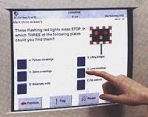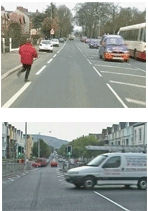Since July 1996 all learner drivers must
take and pass a theory test before booking a practical test. The Driving
& Vehicle Standards Agency (DVSA) introduced the theory test specifically to help
improve user understanding and promote better road safety in light of
rising car accidents. Additionally, the Hazard Perception Test was
introduced from November 2002 and incorporated to aid hazard awareness
amongst new drivers and further promote road safety.
What's Involved?
The theory test is made up of two parts; the multiple choice part
and the hazard perception part. The multiple choice part is delivered
using a touch screen computer and the hazard perception part records
your responses through the use of a computer mouse button.
You need to pass both parts to pass the theory test. If you pass one
part and fail the other you will fail the whole test, and you will need
to take both parts again.
Part One - Multiple Choice
Before the test starts you will be given instructions on how the
test works. You can also choose to go through a practice session of the
multiple choice questions to get used to the layout of the test. At the
end of the practice session the real test will begin.
A question and several answer options will appear onscreen and you have
to select the correct answer to the question by touching the screen.
Some questions may require more than one answer. You will be asked 50
questions in 57 minutes. A case study is included within your test
which means you will be asked 5 questions based around a driving
scenario. You can navigate between questions and ‘flag’
questions that you want to come back to later in the test.
The pass mark for the multiple choice part of the theory test is 43 out
of 50.
After the multiple choice part you can choose to have a break of up to
three minutes before the hazard perception part starts.
Part Two – Hazard Perception
After the break you will then be shown a short tutorial video clip
about how the hazard perception part works.
The hazard perception part is also delivered on a computer but you
respond by clicking a button on the mouse. You will be presented with a
series of 14 video clips which feature every day road scenes. In each
clip there will be at least one developing hazard, but one of the clips
will feature two developing hazards. To achieve a high score you will
need to respond to the developing hazard during the early part of its
development. The maximum you can score on each hazard is five.
You will not be able to review your answers to the hazard perception
test; as on the road, you will only have one chance to respond to the
developing hazard.
The pass mark for the hazard perception part of the theory test is 44
out of 75.




